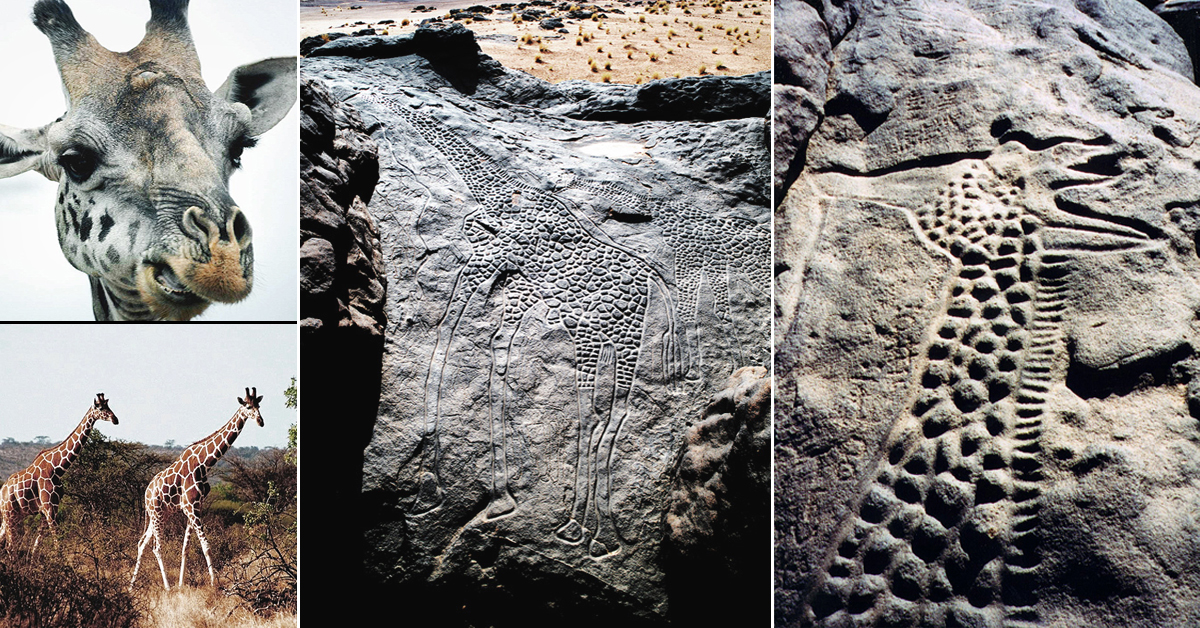


An article by Adam Vaughn on theguardian.com - Researchers discover there are not one but four species of giraffe - reports on the discovery of genetic differences, using DNA analysis, which could boost efforts to save declining giraffe populations.
This timely research reminds us that the giraffe has been recognised and revered by prehistoric populations throughout Africa, as shown by the Neolithic Dabous giraffe petroglyphs in Niger, the largest prehistoric animal rock carving in the world.

Researchers have discovered there is not just one but there are four distinct species of giraffe. This could help boost efforts to save the last dwindling populations.
Analysis of DNA evidence, based on genetic testing in Germany on 190 giraffe, from all of the currently recognised nine sub-species reveals that there are four distinct species. The differences are similar to those between brown bears and polar bears.
Discovery of genetic differences in giraffe #Africa #Dabous #Neolithic #petroglyphs https://t.co/WI2izRE1yg pic.twitter.com/BJBYadwk7T
— Bradshaw Foundation (@BradshawFND) September 9, 2016
Giraffe in Africa have suffered a decline in number over the last 30 years from around 150,000 to 100,000, as their habitat has been turned over to agriculture. But as a single species the giraffe is currently listed as of least concern on the red list of endangered species; a low conservation focus compared to rhino and elephant suggests lead author Dr Julian Fennessy.
Four recommended new species: the southern giraffe, with two subspecies (the Angolan giraffe and South African giraffe); the Masai giraffe; the reticulated giraffe; and the northern giraffe (subspecies including the Kordofan giraffe and west African giraffe). While the southern giraffe was increasing markedly in number, populations in east and central Africa are decreasing. If only 4 separate species, three of those four would suddenly be deemed more seriously threatened by the red list.
Most obvious differences: the shape of their patterns and how far they extend, and how many horns the creatures have.
Reason for decline: habitat loss, fragmentation and human population growth (and agricultural needs) and illegal hunting or poaching.
Co-author Axel Janke, a geneticist at the Senckenberg Biodiversity and Climate Research Centre and Goethe University in Germany, adds that this is also significant from an evolutionary aspect: the giraffe is a very young species and we see evolution, becoming species, in real time.
The study also suggested that the four species do not mate with each other in the wild, an unexpected finding given giraffe move far and wide, and have been shown to interbreed in captivity.
The conclusions of the study, which took five years, will be now be reviewed by the International Union for Conservation of Nature's specialist group on giraffes.
The new study, 'Multi-locus Analyses Reveal Four Giraffe Species Instead of One', was recently published in the journal Current Biology.
Learn more about the Dabous giraffe carvings of the Sahara:
by Bradshaw Foundation
Wednesday 23 July 2025
by Bradshaw Foundation
Thursday 29 May 2025
by Bradshaw Foundation
Monday 03 February 2025
by Bradshaw Foundation
Friday 09 August 2024
by Bradshaw Foundation
Wednesday 24 July 2024
by Bradshaw Foundation
Thursday 04 July 2024
by Bradshaw Foundation
Monday 01 July 2024
by Bradshaw Foundation
Wednesday 20 March 2024
by Bradshaw Foundation
Tuesday 13 February 2024
by Bradshaw Foundation
Tuesday 13 February 2024
by Bradshaw Foundation
Thursday 01 February 2024
by Bradshaw Foundation
Tuesday 28 November 2023
by Bradshaw Foundation
Thursday 23 November 2023
by Bradshaw Foundation
Monday 20 November 2023
by Bradshaw Foundation
Tuesday 31 October 2023
by Bradshaw Foundation
Thursday 26 October 2023
by Bradshaw Foundation
Wednesday 23 July 2025
by Bradshaw Foundation
Thursday 29 May 2025
by Bradshaw Foundation
Monday 03 February 2025
by Bradshaw Foundation
Friday 09 August 2024
by Bradshaw Foundation
Wednesday 24 July 2024
by Bradshaw Foundation
Thursday 04 July 2024
by Bradshaw Foundation
Monday 01 July 2024
by Bradshaw Foundation
Wednesday 20 March 2024
by Bradshaw Foundation
Tuesday 13 February 2024
by Bradshaw Foundation
Tuesday 13 February 2024
by Bradshaw Foundation
Thursday 01 February 2024
by Bradshaw Foundation
Tuesday 28 November 2023
by Bradshaw Foundation
Thursday 23 November 2023
by Bradshaw Foundation
Monday 20 November 2023
by Bradshaw Foundation
Tuesday 31 October 2023
by Bradshaw Foundation
Thursday 26 October 2023
Friend of the Foundation











